
About Catherine de’ Medici
THE HUMAN COMEDY – Honoré de Balzac XVth volume of works of Honoré de Balzac edited by widow André Houssiaux, publisher, Hebert and Co, successors, 7 rue Perronet – Paris (1874)
Philosophical studies

Catherine de Médicis (1519-1589)
ABOUT CATHERINE DE’ MEDICI
The tome on which this study is based was published in 1987. It begins with a composite work Sur Catherine de Médicis, a statement of Balzac’s ideas on royalty, followed by a short story L’Elixir de longue vie, and finally the first panel of the set to which Balzac gave the name Livre mystique, the short story entitled Les Proscrits . The XVth volume cited in the title, published in 1874, makes up the XX-volume Comédie humaine. This XVth volume is the second part of the Philosophical studies. It comprises 12 works, including Massimila Doni, Gambara, L’enfant maudit, Les Marana, Adieu, le Réquisitionnaire, El Verdugo, Un drame au bord de la mer, L’Auberge rouge, L’Elixir de longue vie, Maître Cornélius, Sur Catherine de Médicis: Le Martyr calviniste which is part 1.

Lorenzo II de’ Medici, Duke of Urbino circa 1518
Work dedicated by Honoré de Balzac TO MONSIEUR LE MARQUIS DE PASTORET MEMBER OF THE ACADEMIE DES BEAUX ARTS When you consider the astonishing number of volumes published in search of the point in the Alps where Annibal made his crossing, and we still don’t know whether it was, according to Witaker and Rivazvia Lyon, Geneva, the Saint-Bernard and the Aosta Valley; or, according to Letronne, FollardSaint-Simon and Fortia d’Urbanthrough Isère, Grenoble, Saint-Bonnet, le Mont-GenèvreFenestrelle and the pas de Suze; or, according to Larauzaby the Mont-Cenis and Suze; or, according to Strabo, Polybius and de Luc, via the Rhône, Vienne, Yenne and Mont-du-Chat; or, according to the opinion of some witty people, via Genoa, the Bochetta and the Scriviaan opinion that I share, and that Napoleon not to mention the vinegar with which Alpine rocks have been treated by some scholars; should we be surprised, Monsieur le Marquis, to see modern history so neglected?that the most important points are obscure and that the most odious slanders still hang over names that should be revered? It’s worth noting that the Annibal passage has become almost problematic with each clarification. Father Menestrier believes that the Scoras designated by Polybius is the Saône; Letronne, Larauza and Schweighauser see Isère ; Cocharda scholar from Lyon, sees the Drôme; for anyone with eyes, it lies between Scoras and Scrivia geographical and linguistic similarities, not to mention the almost certain anchorage of the Carthaginian fleet at the Spezzia or in the Genoa harbour? I could understand this patient research, if the battle of Cannes were in doubt; but since its results are known, what’s the point of blackening so much paper with so many suppositions that are, as it were, the arabesques of hypothesis; while the most important story in the world is the battle of Cannes? tempas the Reformation, is so full of obscurity that we don’t even know the name of the man who sailed it. a steamboat in Barcelona at a time when Luther and Calvin were inventing the insurrection of thought. I think we share the same opinion, having each done our own research into the great and beautiful figure of Catherine de Médicis. I therefore thought that my historical studies on this queen would be suitably addressed to a writer who has been working for so long on the history of the Reformation, and that I would thus render the character and the loyalty of the monarchical man, a public tribute, perhaps precious for its rarity. Paris, January 1842
Analysis of the work This title brings together three studies and a short story on the same subject and concern, but written at different times: first, an important preface introducing Catherine de Médicis, followed by two short stories set during her regency, Le Martyr calviniste and La Confidence des Ruggieri, as well as a short story, Les Deux Rêves, featuring Robespierre and Marat on the eve of the Revolution. Les Deux Rêves was written at the very start of Balzac’s career, and appeared in La Revue des Deux Mondes in May 1830. 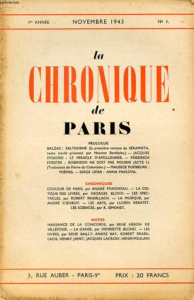
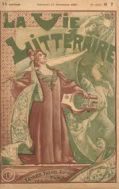 The two historical short stories belong to his mature years: La Confidence des Ruggieri appeared in December 1836 in the magazine founded by Balzac, La Chronique de Paris Le Martyr calviniste was serialized in Le Siècle in April 1841, under the title Les Lecamus. Finally, the preface, which was intended to indicate the general meaning of the work as a whole, was not written until 1843, when Balzac brought these various fragments together under a single title, Catherine de Médicis expliquée, which was later replaced by the current title Sur Catherine de Médicis. This complicated chronology indicates a permanent preoccupation and a realization dependent on circumstances. This concern goes back a long way, and has manifested itself in a variety of ways. As for realization, it was, as usual, a matter of opportunity. A sentence in the preface confirms this concern. “Before undertaking the history of manners in action, the author of this study had patiently and meticulously studied the main reigns of French history, the quarrels between the Burgundians and the Armagnacs, and between the Guise and the Valois, each of which lasted a century. His intention was to write a picturesque history of France. Isabelle de Bavière, Catherine and Marie de Médicis, these three women hold an enormous place in it, dominating from the 14th to the 17th century and culminating in Louis XIV. Of these three queens, Catherine is the most interesting and the most beautiful. “Balzac’s youthful ambitions were summed up in one sentence: his work from 1824 to 1828, which was to make him “the French Walter Scott”. The study of Catherine de Médicis is basically all that remains of this great aborted project. And as you read some of the pages of Le Martyr Calviniste, those that evoke the Paris of yesteryear, you start to regret that this evocation of the past has remained a dream. But, at the same time, this constant preoccupation is based on an equivocation. Taking up a tapestry begun twenty years earlier, it’s another Balzac who settles in front of the workbench where he found the cut frames and moldings of yesteryear. The twenty-five-year-old Balzac who had done this research was a young liberal: was he prepared to excuse the atrocities of civil wars by the imperative duty of dynastic continuity? It’s doubtful. One might even wonder whether the monarchist Balzac who wrote the preface in which he “explains” Catherine de Médicis is sincere when he accepts “Florentine Machiavellianism” as the basis of all political conservatism. Whatever the circumstances, the skill and energy of a single woman surrounded by enemies can be admired in triumph. But should this be the model for all political conduct? Is it not rather the very type of politician at a given moment and in circumstances that will never happen again? It’s this internal contradiction that gives a certain ambiguity to this beautiful preface, in which Balzac mixes the most accurate ideas with the most discouraging examples. For this preface is full of maxims that should be illustrious, that are true for all times; and this wisdom ends, in the description of Medici politics, with apologies that destroy it. Yet it begins with one of the most modern of thoughts, a highly original idea in the 19th century, that of the relativity of history. It’s the first sentence of this preface: “For anyone who studies modern history in depth, it is certain that historians are privileged liars who lend their pens to popular beliefs.” For historians cannot escape the passions of the moment. And Balzac illustrates this with an example taken from the opinion movements of his time. “At all times when great battles take place between the masses and power, the people create for themselves an ogresquecharacter…It hardly mattered that Napoleon’s character was not misunderstood…A few newspaper articles and the emperor Napoleon passed for an ogre…How does error spread and become accredited? This mystery unfolds before our very eyes without our noticing – and Balzac concludes with a striking formula: “History is false at the very moment it is made.” Having so clearly defined the speed of intoxication – we would say disinformation today – Balzac goes on to describe its political effects. He sees public opinion as an element of division or anarchy, and an obstacle to any coherent, firm policy. All power, he says, must be based on unanimous consent. The “salutary principle” of modern states can be summed up in one word: “Una fides, unus dominus”, a single thought and a single master. There is a fundamental antinomy between power and the electoral delegation of power. For “power is action, and the elective principle is discussion. You can’t have politics if you’re always talking”. Hence the phrase that was to have such resonance in the early 20th century: “La liberté, non; mais des libertés, oui.” Balzac specifies: “Des libertés définies et caractérisées”. And he unhesitatingly draws the most serious consequence of this spiritual unity, which he posits as the basis of every solid state: “The right of life and death over innovators”. In his eyes, every opponent is a heretic, and every heretic is a danger to the state. He sees the 16th-century civil war between Catholics and Protestants as an illustration of this necessary absolutism. Calvinists and Protestants were introducing a principle of decomposition into the state, he asserts, based on “the terrible words of liberty, tolerance, progress and philosophy”. What are the State’s defenses against this decomposition? Balzac sums them up in two sentences which are, however, two questions: “Is trickery allowed to power against trickery? Must it kill those who want to kill it?” Two questions to which the life of Catherine de Médicis implicitly provides an answer. Cunning inspired his policy of tilting the balance between the princes of Guise and the Protestant party. The violence culminated in the night of St. Bartholomew’s Day. But, says Balzac, this is the implacable law of all strong powers. “The massacres of the Revolution answer the massacres of St. Bartholomew’s Day. The people who became king did to the nobility and the king what the king and the nobility did to the insurgents of the 16th century.
The two historical short stories belong to his mature years: La Confidence des Ruggieri appeared in December 1836 in the magazine founded by Balzac, La Chronique de Paris Le Martyr calviniste was serialized in Le Siècle in April 1841, under the title Les Lecamus. Finally, the preface, which was intended to indicate the general meaning of the work as a whole, was not written until 1843, when Balzac brought these various fragments together under a single title, Catherine de Médicis expliquée, which was later replaced by the current title Sur Catherine de Médicis. This complicated chronology indicates a permanent preoccupation and a realization dependent on circumstances. This concern goes back a long way, and has manifested itself in a variety of ways. As for realization, it was, as usual, a matter of opportunity. A sentence in the preface confirms this concern. “Before undertaking the history of manners in action, the author of this study had patiently and meticulously studied the main reigns of French history, the quarrels between the Burgundians and the Armagnacs, and between the Guise and the Valois, each of which lasted a century. His intention was to write a picturesque history of France. Isabelle de Bavière, Catherine and Marie de Médicis, these three women hold an enormous place in it, dominating from the 14th to the 17th century and culminating in Louis XIV. Of these three queens, Catherine is the most interesting and the most beautiful. “Balzac’s youthful ambitions were summed up in one sentence: his work from 1824 to 1828, which was to make him “the French Walter Scott”. The study of Catherine de Médicis is basically all that remains of this great aborted project. And as you read some of the pages of Le Martyr Calviniste, those that evoke the Paris of yesteryear, you start to regret that this evocation of the past has remained a dream. But, at the same time, this constant preoccupation is based on an equivocation. Taking up a tapestry begun twenty years earlier, it’s another Balzac who settles in front of the workbench where he found the cut frames and moldings of yesteryear. The twenty-five-year-old Balzac who had done this research was a young liberal: was he prepared to excuse the atrocities of civil wars by the imperative duty of dynastic continuity? It’s doubtful. One might even wonder whether the monarchist Balzac who wrote the preface in which he “explains” Catherine de Médicis is sincere when he accepts “Florentine Machiavellianism” as the basis of all political conservatism. Whatever the circumstances, the skill and energy of a single woman surrounded by enemies can be admired in triumph. But should this be the model for all political conduct? Is it not rather the very type of politician at a given moment and in circumstances that will never happen again? It’s this internal contradiction that gives a certain ambiguity to this beautiful preface, in which Balzac mixes the most accurate ideas with the most discouraging examples. For this preface is full of maxims that should be illustrious, that are true for all times; and this wisdom ends, in the description of Medici politics, with apologies that destroy it. Yet it begins with one of the most modern of thoughts, a highly original idea in the 19th century, that of the relativity of history. It’s the first sentence of this preface: “For anyone who studies modern history in depth, it is certain that historians are privileged liars who lend their pens to popular beliefs.” For historians cannot escape the passions of the moment. And Balzac illustrates this with an example taken from the opinion movements of his time. “At all times when great battles take place between the masses and power, the people create for themselves an ogresquecharacter…It hardly mattered that Napoleon’s character was not misunderstood…A few newspaper articles and the emperor Napoleon passed for an ogre…How does error spread and become accredited? This mystery unfolds before our very eyes without our noticing – and Balzac concludes with a striking formula: “History is false at the very moment it is made.” Having so clearly defined the speed of intoxication – we would say disinformation today – Balzac goes on to describe its political effects. He sees public opinion as an element of division or anarchy, and an obstacle to any coherent, firm policy. All power, he says, must be based on unanimous consent. The “salutary principle” of modern states can be summed up in one word: “Una fides, unus dominus”, a single thought and a single master. There is a fundamental antinomy between power and the electoral delegation of power. For “power is action, and the elective principle is discussion. You can’t have politics if you’re always talking”. Hence the phrase that was to have such resonance in the early 20th century: “La liberté, non; mais des libertés, oui.” Balzac specifies: “Des libertés définies et caractérisées”. And he unhesitatingly draws the most serious consequence of this spiritual unity, which he posits as the basis of every solid state: “The right of life and death over innovators”. In his eyes, every opponent is a heretic, and every heretic is a danger to the state. He sees the 16th-century civil war between Catholics and Protestants as an illustration of this necessary absolutism. Calvinists and Protestants were introducing a principle of decomposition into the state, he asserts, based on “the terrible words of liberty, tolerance, progress and philosophy”. What are the State’s defenses against this decomposition? Balzac sums them up in two sentences which are, however, two questions: “Is trickery allowed to power against trickery? Must it kill those who want to kill it?” Two questions to which the life of Catherine de Médicis implicitly provides an answer. Cunning inspired his policy of tilting the balance between the princes of Guise and the Protestant party. The violence culminated in the night of St. Bartholomew’s Day. But, says Balzac, this is the implacable law of all strong powers. “The massacres of the Revolution answer the massacres of St. Bartholomew’s Day. The people who became king did to the nobility and the king what the king and the nobility did to the insurgents of the 16th century.

Saint Bartholomew’s Day massacres
Such assimilations shed light on what Balzac does not say, or says only half-heartedly, about the nature of politics and the nature of power. All politics is a struggle, and even, strictly speaking, a war: and is conducted according to the laws of war. All power is a fact, a situation of strength that must be maintained. Hence Balzac’s two formulas, so decisive, vigorous, cynical and elusive. The first, when he defines the politics of the Medici: it is, he says, “the history of the politician, and the eternal history of Politics, that of usurpers and conquerors”. And elsewhere, when he quotes Casimir Périer: “All power is a permanent conspiracy”, i.e. a coup d’état that has to be kept going. In this conception, which secretly underpins all of Balzac’s reasoning, power has no legitimacy and claims none. It’s a situation. For Catherine de Médicis, the situation was clear: she was defending a dynasty whose future was under threat. If Balzac confines himself to describing a situation specific to the 16th century, and setting out the principles that are necessary to it, he is doing the work of a historian, and his words can only be judged by historians. But that’s not what he does. From time to time, he takes the floor away from the historian, and it’s the man of the 19th century who speaks, who explains that the ills from which the 19th century suffers have their origins in the principles Catherine fought against. Nowhere does it recommend that the methods used by Catherine be applied in modern politics. But by insisting forcefully on the destructive character of the principle of contestation, by representing the evils threatening the monarchy in the 19th century as the consequence and continuation of the principles Catherine had fought against, he proposes to all conservative politics in the future an objective analogous to the one Catherine had set herself. If the crushing of dissent and the destruction of what he calls sects must be the rule of eternal politics, then what Balzac defines as such is not only absolute monarchy, but also totalitarian politics, In the second part of his preface, Balzac gives examples of Machiavellian politics. He takes them first from the history of the Medici family in Florence. It’s a rather special terrain. Those he later borrows from the regency of Catherine de Médicis are more instructive. For he then encounters, like an inescapable block, the theory that had inspired all the Philosophical Studies on the disorders caused by thought, i.e. by feelings and ideas. A phrase presented not as a principle, but as a simple reflection, suddenly reveals these new perspectives: “Never ask anything great of interests, because interests can change: but expect everything from feelings, from religious faith, from monarchical faith. “The whole political doctrine Balzac has just expounded is shaken by this simple sentence. If ideas and feelings are a crucial element in any policy, and if they are what the prince must ultimately rely on, what can cunning and violence do? Machiavelli may triumph for a while, but he’ll be defeated in the long run. What Catherine de Médicis found in front of her were not great feudal lords she could pit against each other, but collective feelings, blocks of passion and fury, the Catholic party and the Protestant party . And the whole drama, not just the one Balzac brings to light in Le Martyr calviniste, but that of Catherine de Médicis’ regency, shows the vanity of calculation and violence.
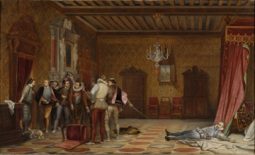
Assassination of the Duc de Guise (Le Balafré) 1550-1588
It’s the guns that decide. Catherine can only pursue a policy of delay. Despite Saint-Barthélemy and the assassination of the Duc de Guise, the Valois lost the crown of France: in the end, it was the House of Navarre that triumphed, and with it, in victory, the only possible policy in the face of passions, the policy of reconciliation that Balzac had forgotten in his political catechism. “Paris is Worth a Mass” is not a ruse, but a pacification edict. It’s the first word that heralds modern politics. The short stories that follow this preface and make up the essay Sur Catherine de Médicis are not anecdotes from 16th-century history. They have a meaning that sheds light on this turning point in history.
The Story The theme of the short story L e Martyr calviniste presents a new type of man, the one produced when the violence of convictions becomes part of history for the first time. Charged by the leaders of the Protestant party with transmitting a secret treaty to the Queen, the young messenger (Christophe Lecamus), subjected to torture, crippled and exhausted, finds the strength to keep silent, despite the apparent ingratitude of those to whom he sacrifices his life.
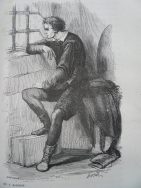
Christophe Lecamus
Faith, conviction and the will to sacrifice have forged a new man: sentiment and the idea show here their full power, both admirable in those it inspires and disruptive of the established order. In La Confidence des Ruggieri, the message is twofold. Balzac notes the consequences of the “overthrow of all religion” by the spirit of examination, and shows the advent of a new way of thinking that takes as its starting point the maxim of atheism: “I don’t believe that God is concerned with human things.” And the two Ruggieri, alchemists and astrologers, set out a new explanation of the order of Creation, enabling them to reveal the future. At the same time, the future they discover heralds the power of ideas and the disorganization they will bring: “Yes, sire,” says Laurent Ruggieri, “if the people triumph, they’ll have their St. Bartholomew’s Day! When religion and royalty are brought down, the people will turn on the great, and after the great, they’ll turn on the rich. Finally, when Europe is no more than a herd of men without consistency because it is without leaders, it will be devoured by crude conquerors.” And he concludes: “Ideas devour centuries as men are devoured by their passions. This ability to divine the future through an intuition of causes and their inscription in the present is one of the theses Balzac had developed in Louis Lambert. And the disorganization of the state by ideologies is the application to society of Balzac’s conceptions of imagination and thought.
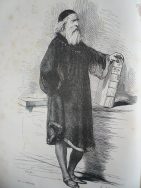
Ruggieri
Les Deux Rêves is simply the reappearance of this prophecy in another form, in the salon of a farmer-general at the time of Louis XVI, through the dreams told to the audience by two seemingly drunken strangers, Robespierre and Marat. Thus, Balzac’s essay on Catherine de Médicis, in which he forcefully asserts seemingly contradictory principles, is basically an illustration of the central thought of Etudes Philosophiques which Félix Davin expressed in these terms: “(M. de Balzac) considers thought to be the most vivid cause of the disorganization of man, and consequently of society. He believes that all ideas, consequently all feelings, are more or less active dissolvers.” But what can cunning and violence do against ideas? We think they’re powerless. Who can be sure it’s not an illusion? Balzacians have been puzzled by these questions. After a fine, scholarly thesis on Balzac’s essay, Nicole Cazauran concludes: “At the crossroads of history and fiction, Catherine de Médicis does not quite become a Balzacian heroine, and the studies devoted to her reflect this unfinished metamorphosis. Short story written by the author in Paris, January 1828.
Sur Catherine de Médicis is a historical novel by Honoré de Balzac, described as “cobbled-together” by Claudie Bernard, and rightly so when one reads the history of the text, which spans the period from 1830 to 1842. Begun at a time when Balzac was still producing youthful works directly inspired by Walter Scott, and completed after the publication of the main works of La Comédie humaine, this work in three parts, to which a fourth in Introductionoscillates between several genres: documentary, advocacy, novel, fantasy tale, even essay. In the Introduction, published in 1842 by Souverain as Catherine de Médicis expliquée, Balzac urges readers to revise their judgments about a queen who was considered bloodthirsty, yet had to face cruel dilemmas.
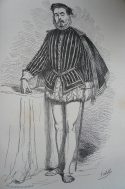
Theodore de Bèze, Protestant theologian
Le Martyr calviniste features an imaginary character: Christophe Lecamus, son of Catherine de Médicis’s furrier and a Calvinist compromised in the queen’s plots, who faces terrible torments and keeps silent to avoid compromising the sovereign. Published in 1841 in Le Siècle, it joined the Etudes philosophiques section of the Souverain publishing house in 1842. This episode in Balzac’s life is, in a way, recorded in Lost Illusions. La Confidence des Ruggieri, published in 1836 in La Chronique de Paris and reprinted in volume form in the Etudes philosophiques section in 1837, recounts Charles IX’s love affair with Marie Touchet on the eve of the St. Bartholomew’s Day massacres. Les Deux rêves, a short story published in 1830 in La Revue des Deux Mondes, then in 1831 in Romans et contes philosophiques, is a form of fantasy storytelling. During a dinner party in the 18th century, two guests, one a lawyer, the other a surgeon (Robespierre and Marat) recount how Catherine de Médicis appeared to them in a dream to glorify the purifying massacres. The four parts(Introduction, Le Martyr calviniste, La Confidence des Ruggieri, Les Deux rêves) were brought together in the second Furne edition of La Comédie humaine in 1846.
Conclusion “In conclusion, how can we fail to admit that the reader of good will has some right to remain disconcerted by these studies on Catherine de Médicis ? ? The fact is, for a man who saw himself as a painter of modern society in action, they testify to his refusal to give up the historical novel, and to his obstinacy in composing a body of work dedicated to the queen of the 16th century. They reveal a novelist often reduced to borrowing the material and even the form of his historical scenes and portraits, and to finding the dynamism of his three stories outside history.
The characters Catherine de Médicis: born Caterina Maria Romola di Lorenzo de Médici on April 13, 1519 in Florence, Italy, and died on January 5, 1589 in Blois, France. Daughter of Lorenzo II de’ Medici (1492-1519), Duke of Urbino, and Madeleine de la Tour d’Auvergne (1495-1519), she grew up in Italy, where she was born on her father’s side. On the death of her parents, she inherited the title of Duchess of Urbino, then that of Countess of Auvergne on the death of her aunt Anne d’Auvergne in 1524. Through her marriage to the future Henry II, she became Dauphine and Duchess Consort of Brittany from 1536 to 1547, then Queen of France from 1547 to 1559. Mother of Kings François II, Charles IX and Henri III, and of Queens Elisabeth (Queen Consort of Spain) and Marguerite (known as “Queen Margot”), she ruled France as Queen Mother and Regent from 1560 to 1563. Catherine de Médicis is an emblematic figure of the 16th century. His name is irrevocably linked to the Wars of Religion between Catholics and Protestants. An advocate of a conciliatory policy, she introduced freedom of conscience for Protestants in France, and made numerous attempts to gain acceptance for the concept of civil tolerance. Lecamus: Pelletier in the service of His Majesty in the 16th century. To a wife, resulting in a son, Christophe, who married Babette Lallier. Pelleterie is the industry of trading and working skins and furs for furriers. Lallier: Goldsmith in the 16th century. Has a daughter, Babette, who marries Christophe Lecamus. Chaudieu: Secret plenipotentiary of Theodore de Bèze and Calvin, who led the French Reformation from Geneva. La Renaudie: Jean du Barry, seigneur de la Renaudie, Protestant gentleman and leader of the Calvinist conspiracy. Admiral de Coligny and d’Andelot, nephews of the connétable de Montmorency and open supporters of Calvinism, were its most notable agents, alongside Condé and Théodore de Bèze. La Renaudie was killed on March 18, 1560 in a skirmish in the forest of Château-Renault (on the right bank of the Loire). Charles IX: Following the failure of the conspiracy to kidnap young François II, the Duc de Guise is promoted to the rank of lieutenant-general of the kingdom. The infirm Francis II died after 17 months of reign. Charles IX, his 10-year-old brother, ruled the kingdom of France for 14 years at the side of the Regent, his mother, Marie de Médicis. Marie Touchet: Marie Touchet was the daughter of Jean Touchet, sieur de Beauvais et du Quillard, king’s counselor and Huguenot lieutenant of the bailliage of Orléans, and Marie Mathy, daughter of Orable Mathy, king’s physician of Flemish origin. Comtesse d’Entragues, born in Orléans in 1549 and died in Paris on March 28, 1638, was the mistress of King Charles IX. Prince de Condé: Historical figure represented in history by a small, hunchbacked stranger wrapped in a cape and sitting on a bench when he meets Christophe Lecamus. The Calvinists fomented a plan to prevent the Guise family from taking power by planning to kidnap the king at Amboise. The Guise would be arrested and Le Condé would take charge of the kingdom’s affairs. The conspiracy was uncovered and Condé imprisoned. Théodore de Bèze and Calvin’s aide-de-camp: historical figures portrayed in the short story alongside Christophe Lecamus. Humanist, Protestant theologian, Bible translator, teacher, ambassador and poet, Théodore de Bèze was the spokesman for the Reformation in France at the Poissy Colloquium, and later during the Wars of Religion. He was the undisputed leader of the Reformed cause throughout Europe, and Jean Calvin’s successor at the head of the Geneva Academy. Jean Calvin was a Protestant reformer and theologian. He adopted the new ideas of the Protestant Reformation in 1533. Sources : 1)
Source analysis: Preface from the 25th volume of La Comédie Humaine published by France Loisirs in 1987, based on the full text published under the auspices of the Société des Amis d’Honoré de Balzac, 45, rue de l’Abbé-Grégoire – 75006 Paris. 2) History and conclusion, Wikipedia ; 3) Instructions sur l’Histoire de France, augmentée et continuée jusqu’au règne….par Charles Constant Le Tellier ; 4) Félicien Marceau, “Balzac et son monde – Gallimard”.
No Comments